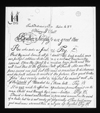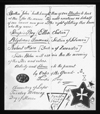Mahatma Letter to H. S. Olcott - LMW 2 No. 3
| Quick Facts | |
|---|---|
| People involved | |
| Written by: | Tuitit Bey |
| Received by: | Henry Steel Olcott |
| Sent via: | unknown |
| Dates | |
| Written on: | June-August 1875 |
| Received on: | June-August 1875 |
| Other dates: | none |
| Places | |
| Sent from: | unknown |
| Received at: | New York |
| Via: | none |
THIS ARTICLE IS A TEST FOR MAHATMA LETTERS EXPANSION PROJECT
THIS ARTICLE IS A TEST FOR MAHATMA LETTERS EXPANSION PROJECT
This letter is Letter No. 3 in Letters from the Masters of the Wisdom, Second Series, in which Master Tuitit Bey reassures Henry Steel Olcott that the Mahatmas are watching over him.
Next letter to Olcott >
Page 1 transcription, image, and notes
|
FROM the BROTHERHOOD OF LUXOR, Section the Vth to Henry S. Olcott. Brother Neophyte, we greet thee. He who seeks us finds us. TRY. Rest thy mind — banish all foul doubt. We keep watch over our faithful soldiers. Sister Helen is a valiant, trustworthy servant. Open thy Spirit to conviction, have faith and she will lead thee to the Golden Gate of truth. She neither fears sword nor fire but her soul is sensitive to dishonour and she hath reason to mistrust the future. Our good brother “John” hath verily acted rashly, but he meant well. Son of the World, if thou dost hear them both. TRY. It is our wish to effect an opprobrious punishment on the man Child and through thy means, brother. TRY. David is honest and his heart is pure and innocent as the mind of a babe, but he is not ready physically. Thou hast many good mediums around thee, don’t give up thy club. TRY. |
NOTES:
|
Page 2
|
Brother “John” hath brought three of our Masters to look at thee after the séance. Thy noble exertions on behalf of our cause now give us the right of letting thee know who they were: Serapis Bey (Ellora Section) Sister Helen will explain thee the meaning of the Star and colors. Activity and Silence as to the present. By Order of the Grand TUITIT BEY Observatory of Luxor |
NOTES:
|
Context and background
Mr. Jinarajadasa provided this background information:
As is well known, H. P. Blavatsky went to America at the direct command of the Masters, and, throughout all her time there, she was in constant communication with several of Them. At first, the detailed direction of her work was under the supervision of the Egyptian Brothers, of whom the chief is the Adept who called Himself Serapis Bey. Associated with Him were others, among whom Tuitit Bey is referred to several times by H.P.B.
Colonel Olcott has not mentioned anywhere the date when he received this letter from the Brotherhood of Luxor. It is evidently among the earliest letters received by him, if not the first.[4]
Physical description of letter
The original is in the Adyar Archives or Adyar ES Archives. Mr. Jinarajadasa described the letter in this way:
The envelope is addressed as follows:
O.G.L. pour Messager Special
Colonel H. S. Olcott,
au No. 7, Beekman Street, New York,
États Unis d’Amérique.
aux bons soins de Madame H. Blavatsky
F.G.S. R +The envelope is of black glazed paper and the inscription on it is in gold ink, which is now somewhat faded. It is closed with a red seal, but the seal is not decipherable. The letter is written in gold ink on thick green paper. The letter is now in four pieces.Cite error: Closing
</ref>missing for<ref>tag
Additional resources
Notes
- ↑ C. Jinarajadasa, editor, Letters from the Masters of the Wisdom Second Series (Adyar, Madras, India: Theosophical Publishing House, 1925), 11-12. In a footnote, Jinarajadasa added: "This person came before the American public in January, 1875, as an exposer of two American mediums, Mr. And Mrs. Holmes. Instructions were received by both H.P.B. and H.S.O. that Child himself was to be exposed, as he was their 'ex-partner and show-manager' (O.D.L., VOL. I, p. 70). Colonel Olcott exposed Child thoroughly in his People from Another World. Says H.P.B. in her Scrap-Book in one place: 'Dr. Child was a confederate. He took money for Holmes’ séances. He is a rascal.' In another place in the Scrap-Book, she writes: 'Ordered to expose Dr. Child. I did so. Dr. is a hypocrite, a liar and a fraud.'"
- ↑ C. Jinarajadasa, 12. Jinarajadasa's footnote added: "H.P.B. writes of this first attempt to form a Society: 'An attempt in consequence of orders received from T.B. . through P. . personating G.K. Ordered to begin telling the public the truth about the phenomena and their mediums. And now my martyrdom will begin! I will have all the Spiritualists against me in addition to the Christians and Skeptics! Thy will. O. M. . !, be done ! H.P.B.'"
- ↑ J. Jinarajadasa, 12-13. In a footnote Jinarajadasa wrote: "Ellora is a series of rock-hewn caves, ten miles north of Daula-tabad, and 225 miles north-west of Bombay. Ellora is still a 'tîrtha' or place of pilgrimage, though it has now no reputation as an occult center. 'In the rainy season a torrent flows at its foot and a great cascade pours over in front, so that the pilgrims can pass along a ledge behind it and bathe in the falling spray, believing that it is Ganga’s holy stream falling over the great God’s brow. For over a mile in length this scrap of rock is carved into monasteries and temples belonging to different sects, among the earliest being the Buddhist Visvakarma stupahouse already described.' A Handbook of Indian Art, by E. B. Havell, p. 79."
- ↑ C. Jinarajadasa, 8.

